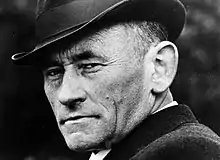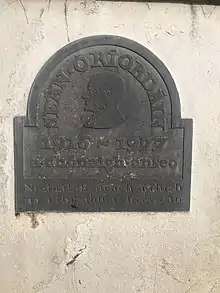Seán Ó Ríordáin | |
|---|---|
 | |
| Native name | Seán Pádraig Ó Ríordáin |
| Born | 3 December 1916 Baile Mhúirne, County Cork, Ireland |
| Died | 21 February 1977 (aged 60) Glanmire, County Cork, Ireland |
| Occupation | Poet, writer |
| Language | Irish |
| Literary movement | Modernism |
| Notable works | Eireaball Spideoige |
Seán Pádraig Ó Ríordáin (3 December 1916 – 21 February 1977), sometimes referred to as an Ríordánach,[1] was an Irish language poet and later a newspaper columnist. He is credited with introducing European themes to Irish poetry, and is widely regarded as one of the best Irish language poets of the 20th century.[2][3][4]
Biography
Early life
Ó Ríordáin was the eldest of three children born in Baile Mhúirne, County Cork, to Seán Ó Ríordáin and Máiréad Ní Loineacháin.[5][6]
English was his first language. His mother spoke English; his father spoke Irish and English. His father's mother, a native Irish speaker, lived next door. His next-door neighbour on the other side also spoke Irish, something Ó Ríordáin attributed to contributing to his own acquisition of Irish. It wasn't long before Ó Ríordáin gained some knowledge of Irish.[7]
When Ó Ríordáin was ten, his father died of tuberculosis. Five years later, in 1932, the family moved to Inniscarra, on the outskirts of Cork city.[5][8] After settling there, Seán and his brother Tadhg were sent to school in the North Monastery Christian Brothers School, on the northside of Cork city.[5]
Professional career
Ó Ríordáin worked as a clerk in the Cork Motor Tax Office from 1936 until his early retirement due to health issues in 1965.[9][10] In 1967, Ó Ríordáin was made a part-time lecturer in University College Cork. Between 1969 and 1976. Ó Ríodáin was UCC's writer in residence. Concurrent with his time in UCC, he wrote a weekly column in The Irish Times, which he continued until 1975.[9]
Health issues

Ó Ríordáin contracted pneumonia at the age of thirteen, and was afterwards ill for most of his life.[11] He was diagnosed with tuberculosis in 1938,[10] and made frequent visits to sanatoria throughout his life thereafter.[11] Ó Ríordáin never married, and died in Sarsfield Court Hospital in 1977. He is interred in St. Gobnait's cemetery, Baile Mhúirne, alongside his father and paternal grandparents.[11]
Poetic works
Eireaball Spideoige
Eireaball Spideoige (A Robin's Tail) is Ó Ríordáin's first and largest collection of poetry, published in 1952.[12] It was published by Sáirséal agus Dill who would serve as publishers for all of his later works as well. Eireaball Spideoige contains Ó Ríordáin's best known poem, Adhlacadh mo Mháthar (My Mother's Burial), from which the collection's title is derived.[12] Adhlacadh mo Mháthair is an intimate exploration of Ó Ríordáin's grief following the death of his mother. According to scholar Louis de Paor, this poem created a new frisson in Irish language poetry when this poem was first published in 1945.[13] In the introduction to Eireaball Spideoige Ó Ríordáin describes his poetry as an attempt to capture "the immediacy of the moment".[2] In the preface he asks "What is poetry?", and answers "A child's mind."[14]
Though now regarded as an integral part of the Irish literary canon,[2] Eireaball Spideoige received mixed reviews on publication in 1952, being criticized for its deviation from traditional Irish poetry in terms of subject matter and personal use of language.[11]
Other works
Three booklets of Ó Ríordáin's poetry were subsequently published: Brosna (Kindling) in 1964, Línte Liombó (Limbo Lines) in 1971, and the posthumous Tar éis mo Bháis (After my Death) in 1978.[15] His later works are marked by a notable dropping of the sentimentality and romanticism of his first collection.[11] In Brosna Ó Ríordáin examines his difficult relationship with the Irish language, and in Línte Liombó he details the conquering of the individual by dispassionate destiny.[11] His collected poems were released in 2011, under the title Na Dánta.[10]
Interpretation
Ó Ríordáin delineates his personal aesthetic and theology in the preface to his first collection of poetry, Eireaball Spideoige, in which he highlights the relationship between artistic expression, poetry in particular, and being. He argues that poetry is to be under the aspect of another and without that relationship one can only ever produce a prosaic narrative. In that same preface, Ó Ríordáin considers an appropriation of an infant's mind as a prerequisite for the poetic act. The poem An Peaca (The Sin) reveals that Ó Ríordáin's ability to write poetry is at once lost if his immediate relation to nature is interrupted.
According to Gearóid Denvir, Ó Ríordáin's poems "seek to answer fundamental questions about the nature of human existence and the place of the individual in a universe without meaning".[16]
Ó Ríordáin has been described as a European poet. The clash between traditional Irish and contemporary European influences was one of the most consistent conflicts in his work. As with all 'modernisers' of tradition, Ó Ríordáin received considerable opprobrium from traditionalists, most notably Máire Mhac an tSaoi.[3] These attacks, particularly by Mhac an tSaoi on the standard of his Irish, did considerable damage to Seán's confidence and added to his already ill health. He never forgave Mhac an tSaoi. In a 1970 'Writer in Profile' television interview with Ó Ríordáin, Mhac an tSaoi phoned the station to say that she 'had never heard better Irish spoken than that by Seán Ó Ríordáin tonight'. Ó Ríordáin's response, as recorded by his biographer Seán Ó Coileáin: 'my bowels moved in disdain'.[17]
As well as writing poetry, he wrote a column in The Irish Times during the latter years of his life in which he spoke vehemently about national affairs. A number of his poems have appeared in English translation, for example, Modern Irish Poetry: An Anthology (ed. Patrick Crotty).[15]
Along with Mhac an tSaoi and Máirtín Ó Direáin, Ó Ríordáin is considered part of "an triúr mór".[18]
Popular Poems
Ó Ríordáin's poems have enjoyed constant popularity, due in part to the exposure gained by the inclusion of his work in the standard Irish curriculum. Poems such as "Fill Arís", "Cúl an Tí" and "Tost" are widely known, and "Fill Arís" was short-listed in a competition run by RTÉ in 2015 which sought to identify "Ireland's best loved poem".[19] "Toil" is a contemplation on the limitations of human will.[20]
"Cúl an Tí" in particular is often taught in Gaelscoileanna throughout Ireland.[21]
Legacy

The writings of Ó Ríordáin were a "seminal influence" on the Innti poetry movement.[14]
Gaelscoil Uí Ríordáin, an Irish-language primary school in Ballincollig, County Cork, is named after Ó Ríordáin.[22]
References
Notes
- ↑ Dawe 2017, p. 210.
- 1 2 3 O'Connell 2019.
- 1 2 "Words from the master Seán Ó Riordáin of Ballyvourney". Irish Examiner. 30 November 2016. Retrieved 17 February 2021.
- ↑ "Mise, Sean O Riordain". Irish Film Institute. Retrieved 17 February 2021.
- 1 2 3 Welch & Stewart 1996, p. 454.
- ↑ "Seán Ó Riordáin Papers". The Library at UCD. University College Dublin. Archived from the original on 15 June 2011. Retrieved 24 August 2021.
- ↑ Ó Gallchoir, Aindreas (1970). "Writer in Profile Seán Ó Ríordáin". RTÉ (in Irish and English). Retrieved 19 October 2021.
- ↑ Ó Coileáin 2018, p. 61.
- 1 2 "Seán Ó Riordáin Papers/Aircív Sheáin Uí Ríordáin". UCD. Retrieved 19 October 2021.
- 1 2 3 Delanty 2021, p. 2.
- 1 2 3 4 5 6 Ó Coileáin 2009.
- 1 2 Kiely 1953, p. 172-184.
- ↑ de Paor 2009, p. 172-181.
- 1 2 Ní Ghairbhí 2014.
- 1 2 Boylan 1998, p. 350.
- ↑ "Apathy Is Out". Bloodaxe Books. Archived from the original on 21 October 2021. Retrieved 21 October 2021.
- ↑ Sewell 2000, p. 48.
- ↑ "Like a Woody Guthrie to the Dylans who came after him: Selected Poems of Seán Ó Ríordáin". The Irish Times. Retrieved 19 October 2021.
- ↑ McGreevy, Ronan. "Shortlist announced for Ireland's best loved poem". The Irish Times. Retrieved 19 October 2021.
- ↑ Modern Ireland in 100 Artworks: 1971– Línte Liombó, by Seán Ó Ríordáin "The collection contains only one long(ish) poem, Toil, which is an extended and unresolved contemplation on the limitations of human volition and autonomy, comparable with the earlier Saoirse, but much more accepting of the human condition as incurably defective."
- ↑ "Cúl an TÍ by Seán Ó Ríordáin". Ireland Calling. Retrieved 6 August 2021.
- ↑ "Gaelscoil Uí Ríordáin School History". Gaelscoil Uí Ríordáin. Retrieved 24 August 2021.
Sources
- Boylan, Henry (1998). A Dictionary of Irish Biography (3 ed.). Dublin: Gill and MacMillan. p. 350. ISBN 0-7171-2945-4.
- Dawe, Gerald, ed. (2017). The Cambridge Companion to Irish Poets. Cambridge: Cambridge University Press. p. 210. ISBN 9781108414197.
- Kiely, Jerome (1953). "Review of Eireaball Spideoige". The Furrow. 4 (4): 172–184. ISSN 0016-3120. JSTOR 27656211.
- Ní Ghairbhí, Róisín (8 November 2014). "Like a Woody Guthrie to the Dylans who came after him: Selected Poems of Seán Ó Ríordáin". The Irish Times. Retrieved 21 October 2021.
- Ó Coileáin, Seán (2009). "Ó Ríordáin, Seán" (PDF). Dictionary of Irish Biography. doi:10.3318/dib.006431.v1.
- Ó Coileáin, Seán (2018). Seán Ó Ríordáin: Life and Work. Translated by Ó hAodha, Mícheál. Cork: Mercier Press. p. 61. ISBN 978-1-78117-610-8.
- O'Connell, Pet (28 February 2019). "Cork poet Seán Ó Ríordáin was a man far ahead of his time". Irish Examiner. Retrieved 24 August 2021.
- Ó Ríordáin, Seán (2021). Apathy Is Out / Ní Ceadmhach Neamhshim: Selected Poems / Rogha Dánta. Translated by Delanty, Greg. Bloodaxe Books, Cló Iar-Chonnacht. ISBN 978-1-78037-536-6.
- de Paor, Louis (2009). "'Adhlacadh mo Mháthar', Seán Ó Ríordáin". Irish University Review. 39 (2): 172–181. ISSN 0021-1427. JSTOR 20720394.
- Sewell, Frank (2000). Modern Irish Poetry: A New Alhambra. Oxford: Oxford University Press. p. 48. ISBN 978-0-198187-370.
- Welch, Robert; Stewart, Bruce, eds. (1996). The Oxford Companion to Irish Literature. Oxford: Clarendon Press. p. 454. ISBN 0-19-866158-4.
- "Words from the master Seán Ó Riordáin of Ballyvourney". Irish Examiner. 30 November 2016. Retrieved 24 August 2021.